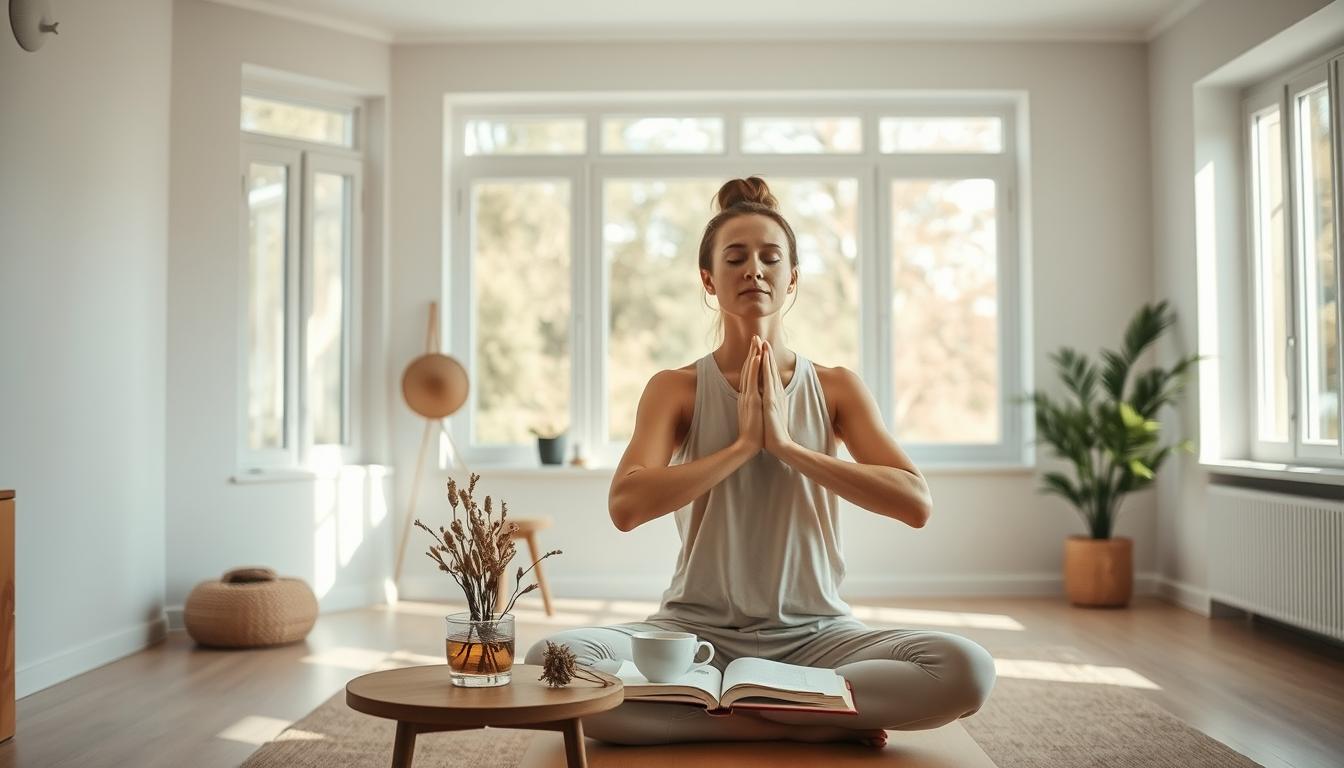Did you know that strong mental fitness can reduce the risk of heart disease and lower blood pressure1? Your mental health is just as important as your physical health, and taking care of it can lead to a more balanced and fulfilling life. In this article, I’ll share eight practical strategies to help you improve your mental health and build resilience.
From mindfulness to setting realistic goals, these strategies are designed to fit into any lifestyle2. Just like physical training strengthens your body, mental workouts can enhance your emotional resilience. Whether you’re new to this journey or looking to deepen your practice, these tips are accessible and effective.
I’ll also address common misconceptions, like the idea that mental health is a quick fix. It’s a journey that requires patience and effort, but the rewards are worth it2. To support your growth, I encourage you to explore our digital library at digitals.anthonydoty.com, where you’ll find e-books, courses, and free webinars.
Ready to take the first step? Register for our free webinar to learn more about these strategies and start your journey toward a healthier, happier you.
Key Takeaways
- Mental fitness is linked to physical health benefits like lower blood pressure and reduced heart disease risk.
- Eight key strategies, including mindfulness and goal-setting, can improve mental health.
- Mental workouts are as important as physical training for building resilience.
- Digital resources like e-books and webinars provide tools for continued growth.
- Improving mental health is a journey that requires patience and effort.
Understanding Emotional Well-Being and Why It Matters
Your mind and body are deeply connected, influencing each other in ways you might not realize. This bidirectional relationship means that your mental health can affect your physical health, and vice versa. For example, high levels of life satisfaction and a sense of purpose are strong predictors of physical health, independent of mental health issues3.
Research shows that staying active can reduce the risk of dementia by 20-30%3. According to NHS statistics, 65.5% of men and 54% of women meet the recommended activity levels3. This highlights the importance of movement for both your body and mind.
Stress hormones like cortisol play a significant role in this connection. Chronic stress can disrupt bodily functions, leading to issues like poor sleep and weakened immunity. On the other hand, managing stress through activities like exercise can lower cortisol levels and improve overall health4.
Beyond physical benefits, a healthy mind enhances cognitive functions like memory, attention, and processing speed. It also boosts workplace productivity and improves sleep quality3. As Marcus Tullius Cicero once said,
“It is exercise alone that supports the spirits and keeps the mind in vigor.”
One case study found that chronic stress can lead to long-term health problems, including heart disease and high blood pressure. However, regular physical activity can counteract these effects by reducing stress and improving mental health4. For more tips on managing stress through exercise, check out this helpful resource.
The Link Between Mental and Physical Health
The interplay between your mind and body is undeniable. Positive emotions and a sense of purpose can significantly impact your physical well-being3. This connection underscores the importance of taking care of both aspects of your health.
How Emotional Well-Being Impacts Daily Life
When your mind is at ease, it reflects in your daily life. Improved focus, better sleep, and stronger relationships are just a few of the benefits. Prioritizing your mental health can lead to a more fulfilling and balanced life.
Emotional Well-Being Exercises to Start Today
Simple daily practices can transform how you handle stress and improve your mindset. Whether you’re looking to feel calmer or more focused, these activities are easy to incorporate into your routine. Let’s explore two powerful techniques: breathing exercises and gratitude journaling.
Breathing Techniques for Instant Calm
One of the quickest ways to reduce stress is through controlled breathing. The 4-7-8 technique is a popular method. Inhale for 4 seconds, hold for 7, and exhale for 8. This helps lower your heart rate and promotes relaxation5.
Another effective method is progressive muscle relaxation (PMR). Tense and release each muscle group, starting from your toes to your head. This practice can ease tension and improve your overall feelings of calm5.
Gratitude Journaling for a Positive Mindset
Writing down three things you’re grateful for daily can shift your focus from stressors to positives. Studies show this practice can restructure neural pathways, enhancing your mindfulness and emotional resilience5.
Here are some prompts to get started:
- What made you smile today?
- Who are you thankful for in your life?
- What small win did you achieve this week?
For guided practices, consider using apps like Reset with the Breath. These tools can help you stay consistent and track your progress5.
| Technique | Steps | Benefits |
|---|---|---|
| 4-7-8 Breathing | Inhale (4s), Hold (7s), Exhale (8s) | Reduces stress, lowers heart rate |
| Progressive Muscle Relaxation | Tense and release muscle groups | Eases tension, promotes calm |
| Gratitude Journaling | Write 3 things daily | Enhances positivity, restructures neural pathways |
Ready to take it further? Join our 30-day challenge to integrate these practices into your daily routine. You’ll notice a significant improvement in your mindfulness and overall well-being.
The Power of Mindfulness for Emotional Balance
Finding balance in life starts with being present in the moment. Mindfulness is a simple yet powerful way to stay grounded and focused. It helps you connect deeply with your surroundings and improves your overall wellbeing.
Practicing mindfulness can reduce stress and enhance your attention. It’s a skill that grows stronger with regular practice. Let’s explore two effective techniques: body scan meditation and mindful walking in nature.
Body Scan Meditation
Body scan meditation involves focusing on each part of your body, promoting relaxation and awareness6. Start by lying down or sitting comfortably. Close your eyes and bring your attention to your toes. Slowly move upward, noticing any tension or sensations.
This practice helps you release stress and achieve a sense of calm. It’s a great way to start or end your day. For more guidance, check out this helpful resource.
Mindful Walking in Nature
Mindful walking emphasizes being present during movement, enhancing your attention and emotional wellbeing7. Choose a quiet path in nature. Focus on the sounds, smells, and textures around you. Feel each step as you walk.
Research shows that spending time in green environments can boost your mood and reduce anxiety. It’s a simple yet effective way to incorporate mindfulness into your routine.
- Body Scan Meditation: Focus on each body part to release tension and promote relaxation.
- Mindful Walking: Engage your senses in nature to stay present and reduce stress.
Both practices are effective in reducing stress and improving emotional regulation6. By integrating these techniques into your daily life, you can achieve a greater sense of balance and clarity.
Physical Activity: A Surprising Boost for Your Mood
Physical activity isn’t just about fitness—it’s a powerful tool to elevate your mood and reduce stress. Studies show that regular movement can reduce feelings of anxiety and depression, improve sleep, and boost overall mood8. Whether it’s a quick yoga session or a high-intensity workout, moving your body can make a big difference.
Engaging in moderate-intensity aerobic activities for 150 minutes weekly is recommended to achieve health benefits8. This could be as simple as 30 minutes a day, five days a week. Even everyday tasks like gardening or cleaning can contribute to your weekly goal9.
Yoga for Stress Relief
Yoga is a gentle yet effective way to calm your mind and body. Specific poses like Child’s Pose and Downward Dog can help lower your heart rate and promote relaxation8. Here’s a simple sequence to try:
- Start with Child’s Pose for 2 minutes.
- Move to Cat-Cow for 5 breaths.
- Finish with Savasana for 5 minutes.
Regular yoga practice can improve mental clarity and reduce stress levels9.
High-Intensity Workouts to Release Endorphins
High-intensity interval training (HIIT) is a great way to release endorphins, the brain’s natural mood boosters. A typical HIIT session includes short bursts of intense activity followed by rest. For example:
- 30 seconds of sprinting.
- 1 minute of walking.
- Repeat for 15-20 minutes.
This type of workout can reduce cortisol levels and improve your mood almost instantly9.
Everyday Movement Counts
You don’t need a gym membership to stay active. Everyday tasks like walking the dog or taking the stairs can contribute to your physical activity goals10. Here’s how different activities compare:
| Activity | MET Value | Benefits |
|---|---|---|
| Walking (3 mph) | 3.5 | Improves heart rate and mood |
| Gardening | 4.0 | Reduces stress and anxiety |
| Cleaning | 3.0 | Boosts energy and focus |
By incorporating movement into your daily routine, you can improve mental health and feel more energized8.
Building Connections to Strengthen Resilience
Resilience grows when you surround yourself with supportive people. Strong relationships with friends and family can provide guidance during tough times and help you bounce back faster11. Whether it’s a heartfelt conversation or a shared activity, these moments build trust and foster a sense of belonging.
Engaging with others in meaningful ways can also reduce stress and anxiety. Studies show that reaching out to loved ones strengthens your ability to cope with challenges12. It’s not just about being around people—it’s about creating deep, supportive bonds.
Quality Time with Friends and Family
Spending time with those you care about can be a powerful way to build resilience. Activities like cooking together, taking walks, or simply sharing stories can strengthen your connections11. These moments release oxytocin, a hormone that promotes bonding and reduces stress.
Here are some ideas to get started:
- Plan a weekly game night with family or friends.
- Host a virtual coffee chat with loved ones who live far away.
- Volunteer together for a cause you care about.
These activities not only bring joy but also create a support system that helps you navigate life’s ups and downs.
Joining Supportive Communities
Being part of a community can provide a sense of purpose and belonging. Whether it’s a local club, a faith-based group, or an online forum, these connections offer encouragement and understanding11.
Volunteering is another great way to build resilience. Helping others not only strengthens your community but also boosts your own mental health12. As the saying goes,
“We rise by lifting others.”
For more tips on building resilience through connections, check out this helpful resource.
Learning New Skills to Fuel Your Sense of Purpose
Learning new skills can unlock a sense of purpose and transform your daily life. Whether it’s mastering a language or tackling a DIY project, skill-building offers cognitive benefits and boosts self-confidence13. Engaging in activities like learning a new language or mastering a musical instrument can enhance cognitive reserve and delay the onset of age-related memory issues14.

Language learning, for example, is a rewarding way to expand your horizons and improve mental well-being15. It’s not just about fluency—it’s about the journey of discovery and growth. DIY projects and creative endeavors can also serve as effective forms of self-care, promoting relaxation and mental well-being15.
Here’s how you can start your skill-building journey:
- Set clear goals to guide your progress.
- Choose a course or program that fits your interests.
- Practice microlearning strategies to stay consistent.
Neuroplasticity research shows that our brains can adapt and grow, even as we age14. This means it’s never too late to learn something new. Whether you’re aiming for a certification or simply exploring a hobby, the process itself can provide a sense of accomplishment and fulfillment13.
Consider joining a 90-day learning challenge to stay motivated. This structured approach helps you track progress and achieve your goals. For more tips on self-management and continuous learning, check out this helpful resource.
Learning new skills isn’t just about knowledge—it’s about finding meaning and enhancing your life. Start today and see how it transforms your sense of purpose.
Giving Back: How Kindness Enhances Well-Being
Acts of kindness have a ripple effect, benefiting both the giver and receiver. Research shows that kindness increases self-esteem, empathy, compassion, and improves mood16. When you help others, you also help yourself by releasing oxytocin, which reduces stress and lowers blood pressure16.
Volunteering regularly is associated with lower blood pressure and increased longevity17. Whether it’s joining a local group or participating in corporate social responsibility programs, giving back strengthens social bonds and fosters a sense of belonging17.
Here are some ways to incorporate kindness into your daily life:
- Engage in micro-volunteering, like writing thank-you notes or donating gently used items.
- Join a community support initiative, such as environmental cleanups or food drives.
- Practice random acts of kindness, like paying for someone’s coffee or offering a compliment.
Companies with volunteer programs report 89% of employees feeling more connected to their company’s mission17. This not only improves job satisfaction but also enhances overall well-being.
To prevent compassion fatigue, balance your giving with self-care. Take breaks, set boundaries, and prioritize your mental health16. As the saying goes,
“You can’t pour from an empty cup.”
Here’s a comparison of different volunteer opportunities and their benefits:
| Opportunity | Time Commitment | Benefits |
|---|---|---|
| Micro-Volunteering | 15-30 minutes | Quick, impactful, flexible |
| Community Cleanups | 2-4 hours | Environmental impact, teamwork |
| Nonprofit Partnerships | Ongoing | Deep engagement, skill-building |
By giving back, you not only improve the lives of others but also enhance your own sense of purpose and fulfillment. Start small, and watch how kindness transforms your world.
Overcoming Common Barriers to Consistency
Staying consistent with your goals can feel challenging, but with the right strategies, it’s entirely achievable. Whether it’s finding time in a busy schedule or adapting activities to fit your lifestyle, small changes can make a big difference. Let’s explore practical ways to stay on track and overcome common problems.
Time Management Tips
One of the biggest barriers to consistency is finding time. Start by monitoring your daily activities for a week to identify at least five 30-minute slots for physical activity18. Use the Pareto Principle to focus on the 20% of tasks that yield 80% of results. This helps you prioritize effectively.
Time-blocking is another powerful tool. Schedule your activities during times when you feel most energetic18. For example, if mornings are your peak productivity period, dedicate that time to your goals. Tools like habit-tracking apps can also help you stay accountable19.
- Start slow and build gradually to avoid burnout19.
- Use work facilities, like walking meetings or standing desks, to integrate activity into your day18.
- Reward progress with positive reinforcement to stay motivated19.
Adapting Exercises for Your Lifestyle
Not every activity works for everyone, and that’s okay. Choose exercises that fit your lifestyle and available time. For example, walking, jogging, or stair climbing can be done in short bursts18. If you’re short on time, even a few minutes of movement can make a difference.
Habit stacking is a great way to integrate activities into your routine. Pair a new habit with an existing one, like stretching while watching TV. This makes it easier to stay consistent19. Additionally, adaptive equipment can help tailor exercises to your needs, ensuring they’re a seamless part of your day.
“Consistency is not about perfection; it’s about progress.”
By focusing on small, manageable steps, you can overcome barriers and build lasting habits. Start today and see how these strategies transform your routine.
Conclusion
Taking small steps daily can lead to significant improvements in your mental health. By focusing on consistency, you can build habits that enhance your overall balance and life satisfaction. The eight strategies we’ve discussed—from mindfulness to physical activity—work together to create a strong foundation for your health.
To get started, consider a 30-day implementation plan. Track your progress using our free checklist, available in our digital library. This will help you stay on track and address common relapse scenarios. Remember, even short activities like a 15-minute walk can boost your mood and energy levels20.
Our premium course bundle offers deeper insights and tools to support your journey. Join our free webinar to learn more and connect with others on the same path. Together, we can create a community focused on improving mental wellbeing.
Start today and take the first step toward a healthier, more fulfilling life. Your journey matters, and every small action counts.
FAQ
How does physical activity improve my mood?
Physical activity releases endorphins, which are natural mood boosters. It also helps reduce stress and anxiety while improving overall physical health.
What are some simple ways to practice mindfulness?
You can start with a body scan meditation or mindful walking in nature. Both activities help you focus on the present moment and reduce feelings of overwhelm.
Can journaling really make a difference in my mindset?
Yes! Gratitude journaling shifts your focus to positive aspects of your life, helping you cultivate a more optimistic outlook over time.
How can I build stronger connections with others?
Spend quality time with friends and family, or join supportive communities. These connections provide a sense of belonging and strengthen resilience.
What if I don’t have time for long workouts?
Everyday movement counts! Even short bursts of activity, like stretching or a quick walk, can improve your mental and physical health.
How does giving back enhance my well-being?
Acts of kindness and volunteering create a sense of purpose and fulfillment, which can significantly boost your overall happiness.
What are some barriers to consistency, and how can I overcome them?
Time management and adapting activities to your lifestyle are key. Start small, set realistic goals, and make adjustments as needed to stay consistent.








